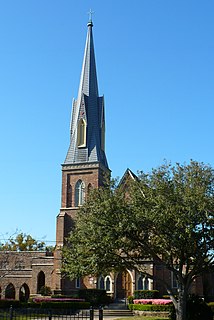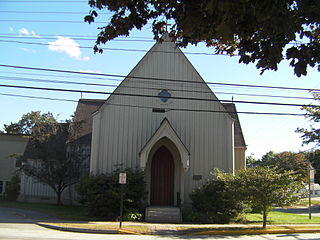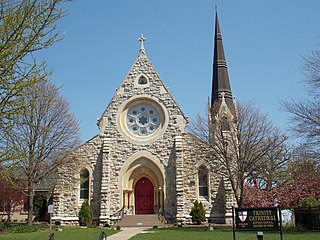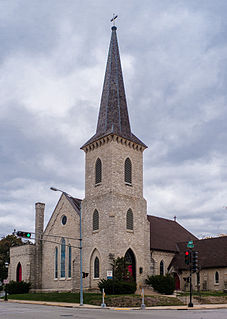
Alexander Crummell was a pioneering African-American minister, academic and African nationalist. Ordained as an Episcopal priest in the United States, Crummell went to England in the late 1840s to raise money for his church by lecturing about American slavery. Abolitionists supported his three years of study at Cambridge University, where Crummell developed concepts of pan-Africanism.

St. Michael's Church is a historic Episcopal church at 225 West 99th Street and Amsterdam Avenue on Manhattan's Upper West Side in New York City. The parish was founded on the present site in January 1807, at that time in the rural Bloomingdale District. The present limestone Romanesque building, the third on the site, was built in 1890–91 to designs by Robert W. Gibson and added to the National Register of Historic Places in 1996.

The Church of the Holy Trinity is an historic Episcopal church at 381 Main Street in Middletown, Connecticut. Completed in 1874, it is one of the city's finest examples of Gothic Revival architecture. Its nearby former rectory, also known as the Bishop Acheson House, is one of its finest Colonial Revival houses. The two buildings were listed on the National Register of Historic Places in 1979.

St. Peter's Episcopal Church, also known as St. Peter's Church, is located in downtown Albany, New York, United States. It was designed in the mid-19th century by Richard Upjohn and his son Richard M. Upjohn in the French Gothic Revival architectural style. It was listed on the National Register of Historic Places in 1972, and designated a National Historic Landmark eight years later. It is also a contributing property to the Downtown Albany Historic District.

Christ Church, founded in 1817, is a historic Episcopal church located at 31st and O Streets, Northwest, Washington, D.C., in the Georgetown neighborhood. Its first rector was Reuel Keith (1792–1842), who with William Holland Wilmer rector of St. Paul's Church in 1818 founded an Education Society to train Episcopal priests. Rev. Keith left this parish in 1820 to accept a position at Bruton Parish Church and teach at the College of William and Mary in Williamsburg, Virginia, although he later returned to the new national capital and taught at the Virginia Theological Seminary when it was founded in 1823.

St. John's Episcopal Church is a historic Episcopal church located on the village green in the village of Highgate Falls in Highgate, Vermont, in the United States. Built 1829–30, it is prominent local example of a Federal style church with Gothic Revival features. On September 3, 1976, it was listed on the National Register of Historic Places.

Trinity Episcopal Church is a historic church in Mobile, Alabama, United States. It was the first large Gothic Revival church built in Alabama. The building was designed by architects Frank Wills and Henry Dudley.

The Church of St. Barnabas is an Episcopal house of worship in Irvington, New York, United States. It is a stone Gothic Revival structure whose oldest sections date to the mid-19th century, with several expansions undertaken since then. The reputedly haunted church complex was added to the National Register of Historic Places in 2000.

St. Paul's Episcopal Church is a historic church at 27 Pleasant Street in Brunswick, Maine. Built in 1845, it is a distinctive early example of a modest Carpenter Gothic design by Richard Upjohn, then already well known for his larger-scale Gothic churches. The building was listed on the National Register of Historic Places in 1978. The rector is Rev. Carolyn H. Eklund.

Holy Trinity Episcopal Church also known as Holy Trinity Memorial Church is an historic Episcopal church building located at 38 Grand Avenue in the village of Swanton, Franklin County, Vermont. Built in 1876 and expanded in 1909-10, the church facilities include a fine example of the Carpenter Gothic in the older section, and the Late Victorian Gothic Revival in the newer section. The church was listed on the National Register of Historic Places as the Parish of the Holy Trinity in 2001. The church is an active parish in the Episcopal Diocese of Vermont; its current rector is the Rev. Reid D. Farrell.

Trinity Episcopal Cathedral, formerly known as Grace Cathedral, is the historic cathedral in the Diocese of Iowa. The cathedral is located on the bluff overlooking Downtown Davenport, Iowa, United States. Completed in 1873, Trinity is one of the oldest cathedrals in the Episcopal Church in the United States. It was individually listed on the National Register of Historic Places in 1974. In 1983 the cathedral was included as a contributing property in the College Square Historic District, which is also listed on the National Register.

St. Peter's Episcopal Church is a historic church at Rector and Gordon Streets in Perth Amboy, Middlesex County, New Jersey. It is the oldest Episcopal parish in New Jersey and contains the oldest extant gravestone in New Jersey. The church building, built from 1849 to 1852 in Gothic style, was added to the National Register of Historic Places on May 12, 1977 for its significance in religion.

Grace Church or Grace Episcopal Church is a historic Episcopal Church located at 600 Cleveland Avenue in Plainfield, Union County, New Jersey, United States. It was added to the National Register of Historic Places on May 10, 2002 for its significance in architecture, art, and music from 1892 to 1930.

St. Luke's Episcopal Church is a historic Episcopal church located at 6th and Chestnut Streets in Lebanon, Lebanon County, Pennsylvania.

St. Philip's Episcopal Church is a historic Episcopal church located at 204 West 134th Street, between Adam Clayton Powell Jr. Boulevard and Frederick Douglass Boulevard in the Harlem neighborhood of Manhattan, New York City. Its congregation was founded in 1809 by free African Americans worshiping at Trinity Church, Wall Street as the Free African Church of St. Philip. First located in the notorious Five Points neighborhood, it is the oldest black Episcopal parish in New York City. Historically, it was extremely influential both while located in lower Manhattan and as an institution in Harlem, and many of its members have been leaders in the black community. In 2020, it reported 188 members, 111 average attendance, and plate and pledge income of $224,827.
St. George's Episcopal Church is a historic Episcopal Church building located in Le Mars, Iowa, United States. Designed in the Carpenter Gothic style of architecture, it was erected in 1881. It is one of the few remnants of the English era in Le Mars' early history. The church building was listed on the National Register of Historic Places in 1976.

The Alexander Crummell School is an Elizabethan Revival school building, located at 1900 Gallaudet Street and Kendall Street, Northeast, Washington, D.C., in the Ivy City neighborhood.

Lincoln Temple United Church of Christ was a congregation of the United Church of Christ located since 1880 in the Shaw neighborhood in the Northwest Quadrant of Washington, D.C. The church building was completed in 1928 and is a historic structure that was listed on the National Register of Historic Places in 1995. The church is also listed on the city's African-American Heritage Trail.

St. Matthias Episcopal Church is a Gothic Revival-styled limestone-clad church built from 1851 to 1855 in Waukesha, Wisconsin. It was built by St. Matthias parish of the Episcopal Church, now in the Diocese of Milwaukee, and is the oldest church building in Waukesha that survives basically intact.

Holyrood Episcopal Church is a Protestant Episcopal Church located at 715 West 179th Street in the Washington Heights neighborhood in upper Manhattan, New York City.





















